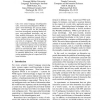19 search results - page 1 / 4 » Automatic Sense Disambiguation of the Near-Synonyms in a Dic... |
CICLING
2003
Springer
13 years 10 months ago
2003
Springer
We present an automatic method to disambiguate the senses of the near-synonyms in the entries of a dictionary of synonyms. We combine different indicators that take advantage of th...
FLAIRS
2011
2011
Impact of Word Sense Disambiguation on Ordering Dictionary Definitions in Vocabulary Learning Tutors
12 years 8 months ago
Past research has shown that dictionaries and glosses can be beneficial in computer assisted language learning, particularly in vocabulary learning. We propose that L2 vocabulary ...
CICLING
2003
Springer
13 years 10 months ago
2003
Springer
This paper presents a graph-theoretical approach to lexical disambiguation on word co-occurrences. Producing a dictionary similar to WordNet, this method is the counterpart to word...
COLING
1990
13 years 5 months ago
1990
In this paper, we describe a means for automatically building very large neural networks (VLNNs) from definition texts in machine-readable dictionaries, and demonstrate the use of...
NAACL
2010
13 years 2 months ago
2010
Like most natural language disambiguation tasks, word sense disambiguation (WSD) requires world knowledge for accurate predictions. Several proxies for this knowledge have been in...

